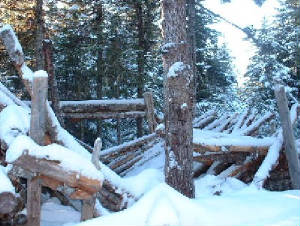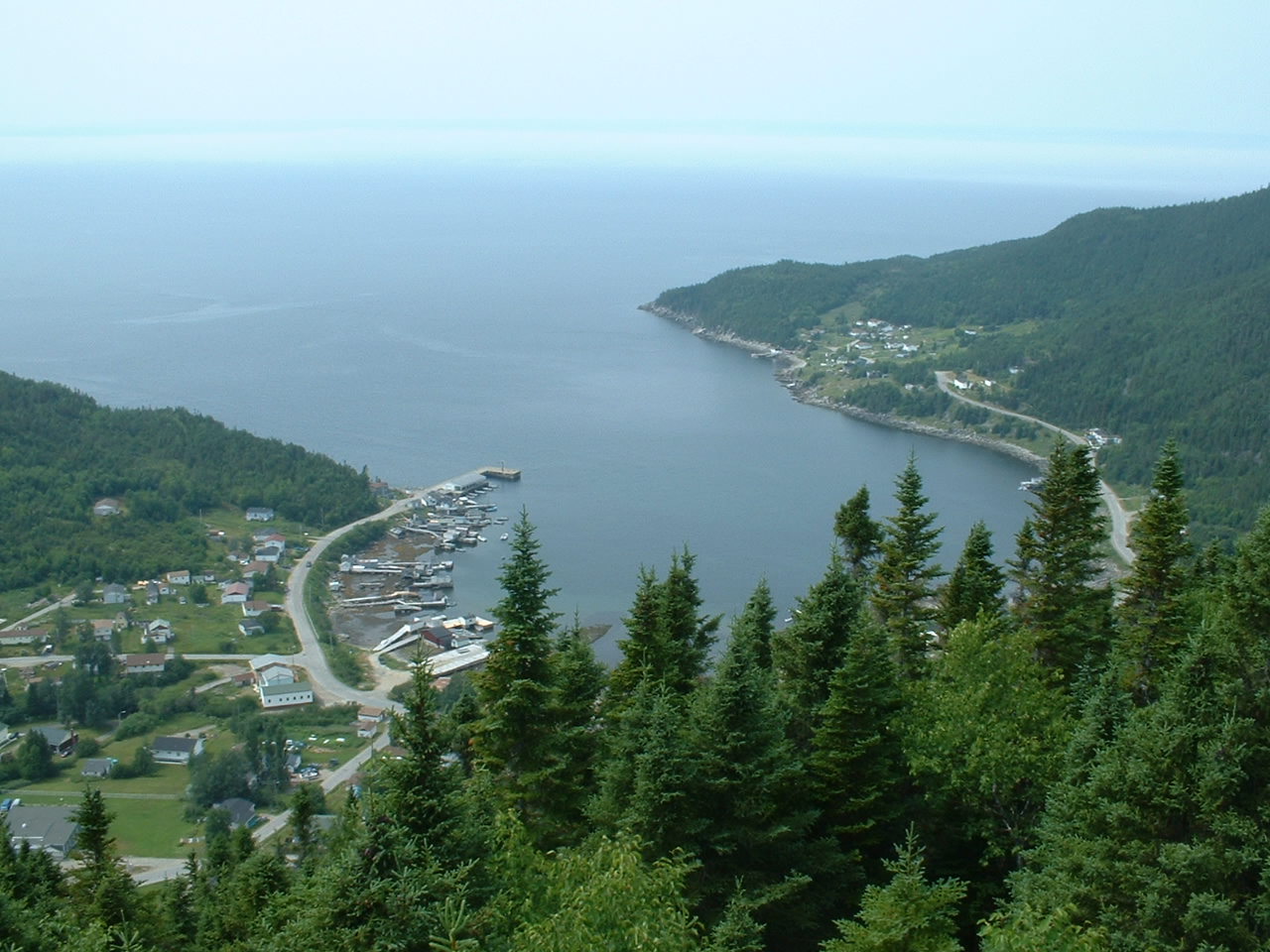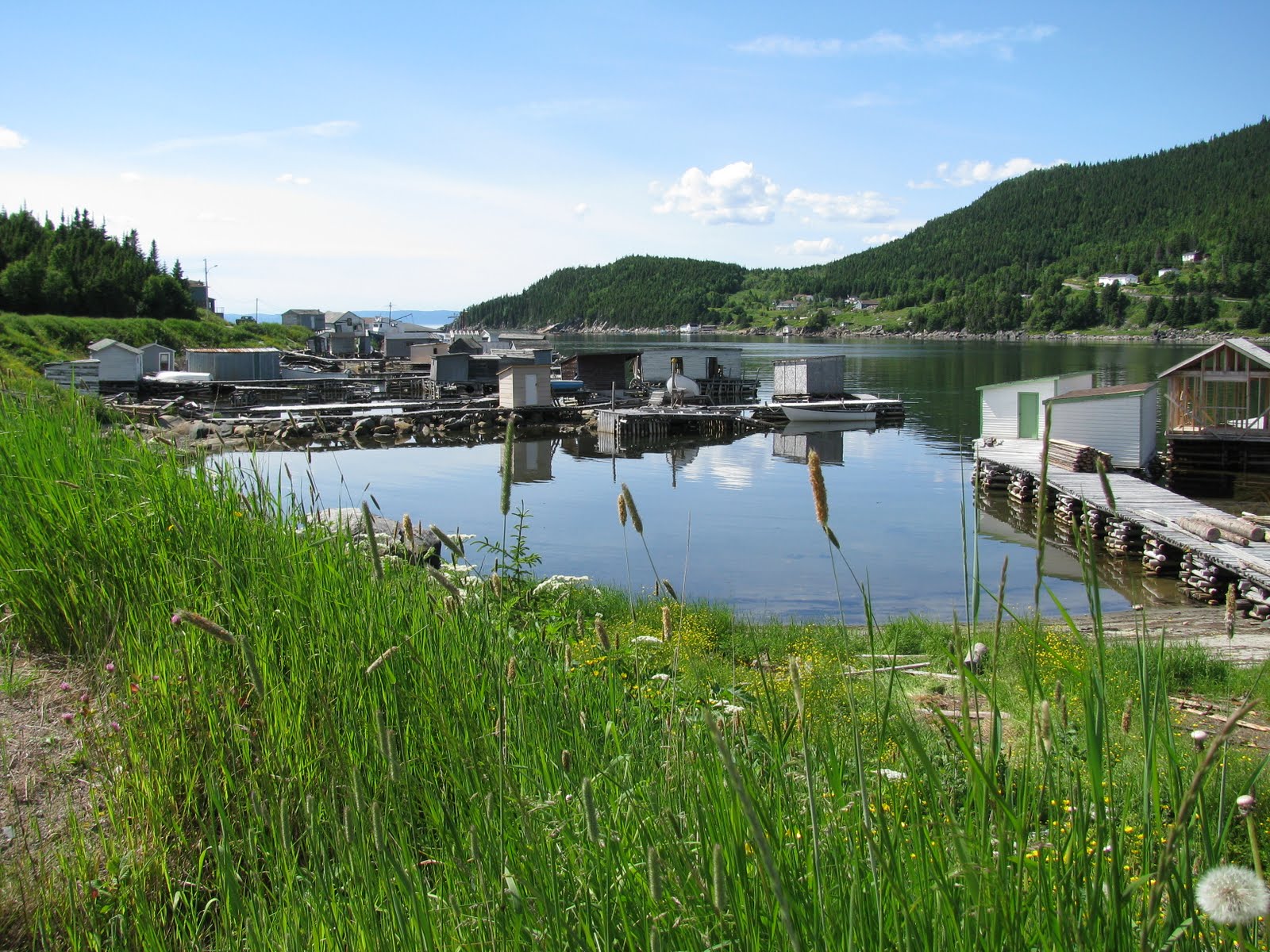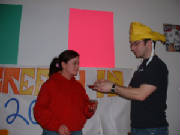|
| Brion Robinson photo. |

|
| Cabin with roof caved in. |
The Cabin that was not meant to be
“Here it is.” Danny said.
“Everything’s caved in under the snow.”
These were the frozen remains
of the first and only log cabin that my friends and I had ever built. Seven years later it’s something that we still
talk about.
“That was some cabin.”
But, it was the cabin that was not meant to be.
It’s shape went through
some changes since I last saw it. The logs on the roof had all caved in and were camouflaged in a white blanket of sparkling
snow. Everything was frozen in place. The collapsed roof pushed the walls apart
to the point of collapse. It looked like a giant passing by had used the roof
as a stool. However, a more likely cause was the record snowfall of 2001.
Eric, Steve, Brad, Corey,
Danny and I had all been hanging around together since junior high. We went to
parties, shared some beers, and even chased the same girls. There were always
at least two of us doing something. Even building cabins was nothing new. This was our fourth attempt at building a cabin.
We had the man power, supplies and lots of time on our hands.
Tucked away in the woods a cabin was a place away from everything; our town, our parents, our responsibilities
at home. It’s a place to call our own.
The building site was a
great location... just up the hill from a small pond and tucked away behind thick brush.
It was out of the way and hard to find.
After the logs were cut
the cabin soon began to take shape. The walls and roof were soon put up along with a door and window. A log cabin definitely has character. It symbolizes the rough neck lifestyle of hunting and camping. It’s a shelter that’s dependable, strong and trustworthy. For us it was a place for parties, for staying over night on fishing trips, or just stop for a mug up (because
food always tastes better in the woods.)
Through the roar of chain
saws and the thumping of nails we fitted each log into place. They fit evenly
by sawing their sides flat. Any cracks were stuffed with whatever we could find; Insulation, rags and even plastic bags. I
hated using the insulation because it irritated my hands.
After school we stayed
until dark. I used to come back home smeared with gooey muhr and smelling like
smoke. Construction was almost finished. We started building in late January
and by Easter we were nailing the last floor boards and filling the last few cracks. Danny and Corey had split off to build a cabin themselves (which is still standing.)
But Eric, Brad Steve and I stayed on. We even had some help from Steve’s
father and Eric’s older brother.
The whole cabin was made
of logs; The walls, the roof and there was even a tree growing up at one end
to act as a post for the roof. The floor was made of boards. It measured twelve
by twelve.
When the stove’s
belly glowed red hot the cabin heated up fast. For the first couple of days frozen
water trapped inside the roof logs would melt and drip down like rain. I
was usually soaked after a few minutes.
Like many cabins our most
impressive appliance was the cold black wood stove. It was built by Eric’s
uncle. The stove was the size of a trash can and it had a round belly and flat
top for cooking. It was made from iron and weighed a ton. The shapes of a small rabbit was welded to the door. This
added to its rugged charm.
Word about our cabin travelled around fast. We soon had visitors
coming by to what we had built.
“You got ‘er
scalled boys, I thinks.” And “those are some big sticks you got there.”
However, not all the visitors
were impressed.
We had only our bunks to
finish before our construction was cut short. The town council said our cabin was too close to the watershed so we had to
tear it down.
Through curses and complaints
we dismantled the floor boards and salvaged whatever could be used again. The
bulky black stove is currently warming up people in its third cabin.
Although the cabin’s
legacy was over before it began, we can say that we did build a log cabin. It
was the place where I first used a chainsaw and trapped my first rabbit (which I ate later that week.)
“It’s too bad
you guys had to tear it down.” Danny said.
I took some photos of the frozen logs to show Steve. As our feet broke through the freshly packed snow while leaving
I looked back. However I didn’t look back at a demolished cabin, I looked
back at a place of friendship and good times.

| Brion Robinson photo. |

|
| This is Seal Cove from the Bond Lookout. |
Lookout below
A
small black figure stands alone on a red platform high above Seal Cove. He is playing a set of bag pipes. Its low hum and shrill chords settle in the streets and pass through open kitchen windows. They find their way through my open bedroom window. The whining
melody wakes me up. Downstairs, dad is leaning over the sink and looking up at
the hills through our oversized black binoculars.
“Dr.
Bond’s back,” dad said.
For
the second time in his life Dr. Bond was using the high hills like no one else had done before.
Dr. Bond played his bag pipes from the Bond Lookout. This is one of the
highest points in Seal Cove, White Bay. A countless number of red steps take visitors to the top where the lookout faces White Bay. Besides moose and icebergs, it’s a major attraction in Seal Cove.
The
Bond Lookout is named after Dr. Bond because he hang-glided from this spot when it was just a bare rock. On sunny days he hiked over slippery rocks and through black
clouds of flies to drag his glider to the top. His way down was more graceful.
Upon
reaching the summit, he assembled his glider and jumped off. I remember putting my hand over my eyes to see Dr. Bond’s
white hang glider bob around in the blue summer sky. It looked like a giant sea
gull. The glider dived and bounced around as it circled over the boats and wharves in the cove. His bumpy ride always ended
with a smooth landing in the South end of town on the softball field. It’s
flat and free from telephone wires. No one has seen Seal Cove like Dr. Bond.
High
places have always been an attraction to Newfoundlanders. Most outport towns
hidden trails or that include a panoramic view of the bay or woods. In the past
there were no signs or clear trails leading to these scenic vistas. They were
only known to locals. Their commercial potential to attract tourists has only
recently been noticed. Today most towns have cut trails and built small parks
for visitors.
The first time I hiked to the top there were no steps. There were only
slippery black rocks and green moss. I followed the grown ups right to the top
where a lumpy black rock the size of a car faced White Bay. We plopped down on it. A cool breeze pushed the black flies off my face.
From the top, White Bay opens up and seagulls fly below instead of up above.
To the South, Southern Arm’s salt water slithers into the green hills.
To the North, the pound rocks fishing grounds cuts into the cove and to the West, the Great Northern Peninsula lies
on the water.
From
the top, the landscape stays the same but the scenery is always different. Depending
on the time of the year, we can see the black outer edge of white pack ice or boats jigging for squid. Sometimes whales even blow water and show off their tales in the bay.
Today,
no one hang glides off the lookout and some take it for granted that we can just walk up steps to get there. A few years ago, the bright red steps leading to the lookout began to rot and fall apart. Steps broke in half and the hand rails fell down. The old
platform was full of carved-in names and initials and it eventually burned down.
However, everything was rebuilt. Visitors are now greeted by a sign, well-built
steps, a bigger platform and fresh new red paint.
In a few years the steps the red paint will have to be repainted and repaired.
But this isn’t a sign of abandonment. It shows that people still
want to see a hanging view of White Bay.
After about fifteen minutes the pipes stop playing
and the town falls silent again. The black figure and his bag pipes quietly disappear
from behind the red platform. No has played bagpipes from there since.

| Brion Robinson photo. |

|
| Seal Cove harbour from the road. |
RUN!!!
The flat white tops of five icebergs are glistening under a full moon. Their silver
outline adds a flicker to the black sea. It was a nice surprise. Turning around
to jog down rooms`s hill I can see the whole town of Seal Cove and across White Bay. I
can faintly hear the ground grinding beneath my feat as each grain shifts to from the
imprint of my sneaker. With every step my feet roll from heel to toe in
a rocking motion. After about twenty minutes of running my body is just warming
up. From my right a cool salt sea breeze instantly dries my sweaty hairline. Below, the road winds around the rocky shoreline and up around town.
I have been jogging around Seal Cove and taking the same routes for the last eight years.
The first time I ever ran around town or "around the block," I was 15 and I never thought I would make it. When I got home I was drenched
in sweat and barely able to talk but I felt great. Two years later I joined the
school cross-country running team.
Since then I still have the same refreshing feeling after jogging but the routes have
gotten longer. I have measured three different routes around town. They are either five, four or three kilometres. I measured
them with the odometer from the car.
I love running because It's a great
excuse to get outside for some exercise. Although it’s very challenging
and requires a lot of energy. After the run is over I always feel very refreshed
and relaxed.
Seal Cove is a great place for running. There
are enough hills in the community to make the routes challenging and practically no traffic to makes them comfortable.
Besides the obvious healthy reasons for running there are also social benefits. Not through
running clubs or sports teams, but by stopping to talk with people around the community.
Since most outports are so small, a runner's route (like my
own) incorporates most or all of the town.
While jogging around town I say to hello to most everyone and sometimes stop to chat.
On a few occasions I have even run into familiar homes for a quick visit (and a beer.)
I am by no means a serious runner.
I also get to see what's happening
around town. I can see who=s doing what. Some people are doing construction jobs to their house or their shed.
Someone has a new car. Or I might even see someone taking their frisky
new puppy for a walk.
Some might say that all of these things can be done by driving. We can see the community
and it is much more comfortable. But there is a difference. Running or walking is one the simplest and slowest modes of transportation.
While driving in a car we are concentrating on driving or we can be distracted by music. This takes away from our natural tendency to explore what else is happening.
When university
is over in the spring I always look forward to my first run around the block.

| Brion Robinson photo. |

|
| The Newfoundland dialect is an integral part of Screech-Ins. |
The way we talks
"Ay buddy, you goin’ to Newfoundland?" hollered a man wearing a baseball cap, leather jacket and cowboy boots. He
was standing in a long line up of tired-looking travelers in Toronto’s Pearson International Airport.
"Come up here if you wants to get home today."
He said he heard my accent and thought I could use some help heading back East.
Me and a girl from New Brunswick had been waiting for hours in a line up of thousands of people carrying boxes and luggage
that stretched the full length of the massive airport. An electrical storm the night before had backed up dozens of flights.
The man told us he was heading back to the island for the holidays but his flight got delayed and he got stranded in the
airport over night.
He was standing in the longest of two line ups heading towards the check in counter. He noted that it was long but moved
fast-and it did.
Within an hour we had our tickets and bags checked in. That day, my accent was my ticket home.
As Newfoundlanders and Labradorians, we’re endowed with a distinct manner of speaking that’s been handed down
and perfected by our ancestors. The Newfoundland and Labrador accent is a multifarious mix of English, Irish, Scottish, French,
Portugese and Gaelic words and grammar that work together in their own competent way.
Be it mending nets in the store or sawing down trees in the woods, settlers worked together and shared a yarn. For over
500 years their stories and expressions traveled at the speed of sound from mouth to ear all over the rocky landscape.
The accent and dialect is so unique we even have our own official dictionary, Dictionary of Newfoundland English. The yellow
covered book was put together and edited by professors from Newfoundland and Labrador, the United States and even Europe.
It’s words represent our rich multilingual history and they distinguish our dialect among others in the world.
But despite its attributes, the dictionary is a silent record of our linguistic heritage. It doesn’t speak nor listen.
That’s our job.
We need to preserve our dialect because it tells us and others who we are and where we come from. We preserve our words
and phrases by using them. We give our dialect life.
But we can also kill it. We kill our words when we don’t use them.
Unfortunately, dozens of our words die every year. The death toll rises every time a Newfoundlanders and Labradorians leave
for the mainland where our dialect is sometimes unrecognizable and regarded as funny. Most expatriates drop the accent and
pick up new mainland words in order to fit in.
Our dialect has also been bombarded by the standard English of television and radio stations for years. It’s easy
to pick up and for some, it sounds more sophisticated.
We could probably salvage a few words if we stayed home and cut the power. But that would be silly.
The best way to save our language is to use it. Although its words don’t have much use on the mainland that doesn’t
mean its not important. The mainland is full of recognized different languages and dialects and ours should be one of them.
Sometimes, the best way to preserve something is to use it.
|

